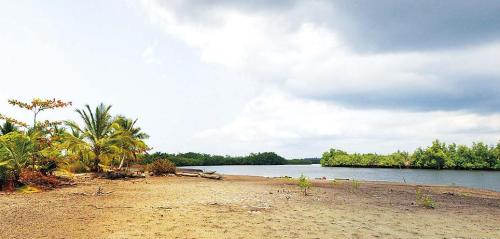Gabon’s rainforests could be the next big destination for ecotourism
LIBREVILLE ― It’s an extraordinary scene. As our small, twin-propeller plane flies over the the western coast of Gabon, the scale of the vegetation is magnificent.
The trees, which look like an endless array of giant broccolis, are stretched along the coastline as far as the eye can see.
Welcome to Gabon’s rainforests.
Located on the equator in west central Africa, Gabon is bordered to the west by the Atlantic Ocean, to the north by Equatorial Guinea and Cameroon, and to the east and south by Republic of the Congo.
Gabon covers an area of 267,000 square meters, or twice the size of South Korea, and the forests cover around 80 percent of its territory.
Its oil and mineral reserves, combined with a small population of just over 1.5 million, have helped Gabon become one of Africa’s wealthiest countries.
But the government realized the country was too dependent on its oil, so it created 13 national parks in 2002 ― accounting for more than 10 percent of the country’s total land ― and assigned the National Parks Agency to manage this grand scale natural habitat.
Gabon’s picturesque forests are now home for the biggest population of leatherback turtles, more than 50,000 elephants and 15,000 rainforest gorillas, according the National Park Agency of Gabon.
“The government saw the parks as a way to boost our country’s economy,” said Omer Ntougou, the communication director of NPAG.
Gabon’s forests provide a vital habitat to everything from sea turtles and whales to forest elephants, rhinos, gorillas, buffalo and numerous plant and bird species found only in Gabon, according to him.
“Gabon could be the next big thing in African ecotourism,” he added.
Loango National Park
Of the 13 designated parks, Loango National Park is one of the popular destinations for tourists. Situated along the coast, some 260 kilometers south from Libreville, the capital of Gabon, the park is home to a mix of wildlife, including sea turtles, elephants and gorillas. If lucky, one can also see hippos patrol the beaches.
Lope National Park
Located in central Gabon, Lope National Park became the first protected area in Gabon in 1946. The park is the last remnants of grass savannas in central Africa created during the last Ice Age.
Langoue Bai
Langoue Bai, which was discovered only a few years ago, is a unique safari destination for bird watchers and researchers.
 |
Pongara National Park, Gabon (National Parks Agency of Gabon) |
Pongara National Park
Pongara Park is accessed by a 20-minute boat ride from Libreville. In the park you can enjoy pleasant walks along the coast while seeing leatherback turtles at the height of the season.
Many people here might not be familiar with Gabon, but the African nation was recently in the lime light for successfully co-hosting the 2012 Africa Cup of Nations with Equatorial Guinea.
Arriving in Libreville, you might be stunned by what is shaping up to be Africa’s next tourism destination. Construction is everywhere in the city in an obvious state of development.
However, Gabon is still a difficult destination, suitable perhaps for the most hardened travelers. Low-coast airlines are a rarity in Africa and connections often slow and erratic.
Although most of the roads in Libreville are in very good condition, admittedly, transport in Gabon is still unreliable ― taxis are basically the only option for visitors.
Most national parks in Gabon including Loango are extremely remote, though that is why they are still unspoiled, making them hard to reach for visitors.
Developing the infrastructure to create a system that draws ecotourists will take time, admitted the communications director.
Despite the government’s huge investment, the difficulty, he said, is most residents in Gabon don’t want to pay money to go to the national parks.
“Because when we go to our village, in our house we can see all the animals we want to see,” he said.
Still, he believes Gabon can make the parks the next destination for travelers who want to experience some of the most unspoiled places on Earth.
“But we have to work hard and hard to build a circuit of national tourism before that,” he added.
By Oh Kyu-wook, Korea Herald correspondent
(
596story@heraldcorp.com)






![[Exclusive] Hyundai Mobis eyes closer ties with BYD](http://res.heraldm.com/phpwas/restmb_idxmake.php?idx=644&simg=/content/image/2024/11/25/20241125050044_0.jpg)
![[Herald Review] 'Gangnam B-Side' combines social realism with masterful suspense, performance](http://res.heraldm.com/phpwas/restmb_idxmake.php?idx=644&simg=/content/image/2024/11/25/20241125050072_0.jpg)
![[Herald Interview] 'Trump will use tariffs as first line of defense for American manufacturing'](http://res.heraldm.com/phpwas/restmb_idxmake.php?idx=644&simg=/content/image/2024/11/26/20241126050017_0.jpg)